Is Finland Really A Closet Member Of The Eurozone Periphery?
By Edward Hugh
This post first appeared on my Roubini Global Economonitor Blog “Don’t Shoot The Messenger“.
At a time when many eyes look hopefully towards the ECB for the kind of action which may prove to be the salvation of the much beleaguered Eurozone other, more critical, ones are casting themselves back over the recent track record of the institution itself, and asking what, if any, responsibility the Frankfurt-based bankers have for having allowed Euro Area government finances to fall into the sorry state they are now in.
Lessons From Japan?
No idle question this, since it harks back to the time when a good deal of attention was focused on the Bank of Japan, and how much responsibility policymakers there had for the deflation trap into which the country’s economy eventually fell. Now according to a very influential paper published by the Board of Governors of the US Federal Reserve System back in 2002 (Preventing Deflation: Lessons from Japan’s Experience in the 1990s, by Alan Ahearne and colleagues) the most important concern raised by Japanese policy during the country’s first “lost decade” was not that policymakers did not predict the oncoming deflationary slump –that in itself was not especially surprising, after all, neither did the majority of analysts and forecasters – but that they did not take out sufficient insurance against downside risks through a continuous precautionary loosening of monetary policy. Simulations carried out at the time using the FRB/Global model lead the authors to the conclusion that, had the BOJ lowered short-term interest rates by a further 200 basis points at any point between 1991 and early-1995, at least the first bout of deflation could have been avoided. (On the other hand the model indicated that loosening after the second quarter of 1995 would have been too late to avoid deflation, as by that time inflation had already fallen below zero.)
Well, that was 2002, and who else apart from myself and a few other policy wonks with good memories now remembers the once renowned Ahearne et al paper? The Japan lesson was “learnt”, and then conveniently forgotten it seems. Now, of course, the Euro Area is not actually caught in Japan style deflation, but this isn’t over yet, and we don’t know how the story is going to end. What we do know is that the region is once more falling back into recession, while the economy has been submitted to a triphasic cocktail of fiscal austerity, monetary tightening and regulatory pressure for bank recapitalisation. And, of course, with a massive public and private overhang, a credit crunch that is tightening by the day and a backdrop of rapidly ageing populations the deficiency in domestic demand the region is suffering from looks even more visible to the naked eye than that famous hole which appeared in the side of the Titanic must have been after its unfortunate contact with the iceberg. Which is only another way of saying that the deflation risk is a real and ever present one, and a bit of downside insurance would have been a good thing. Prescient even.
Using The Ejector Seat Without A Parachute
Just to ask the question whether policymakers got their ”mix” right here seems like some kind of sick joke in bad taste. Virtually no insurance was taken out against possible downside risks to the price level (inflation was consistently seen as being a much more pressing problem), even if (going by the PMI output prices, see chart below) price pressures seem to have been on a downward path since early 2011. In any event, what inflation there was in the Eurozone was mainly the by-product of imported commodity prices or the knock-on impact of VAT increases, and in no case could it be seen as the result of domestic demand “overheating” which is really what monetary policy is equipped to deal with.
So the much discussed ECB “exit strategy” seems to have been applied far too early and far too systematically. In both the case of extraordinary liquidity measures, and in the case of interest rate policy, Mario Draghi has had to put the motor into reverse gear, and emphatically so. Not that this outcome was that hard to see at the time, as I explained in a post on the CNBC blog back in March (Chronicle of a Policy Error Foretold).
Crunch, Crunch, Something Funny Is Going On Here!
The parallel with Japan in fact extends beyond simple interest rate policy. Issues associated with the capitalisation of the banking system also have a certain parallel, as can be seen in the chart below (which comes from a Richard Koo presentation). Fiscal and monetary measures taken following the outbreak of the crisis worked initially, but since the core of the problem was not addressed keeping all the zombie loans going soon gave the banks funding problems which lead to a second credit crunch.
The interesting point here is that this process seems to be now being repeated in the Eurozone, as a second credit crunch firmly starts to set in. If you look at the chart below (which comes from a report by Unicredit), then you will see that the credit standards applied by banks (as extrapolated from the ECB monthly survey) have been tightening for some months now (and are obviously continuing to do so, hence the recent batch of liquidity measures. As Marco Valli (who wrote the Unicredit report) also points out, these lending conditions move in tandem with the PMIs (red line) which means that as they banks steadily close the lending spigot activity in the real economy slows correspondingly.
Spread Them Wide
So obviously the ECB has been doing quite a bit wrong since the time of those wonderful “how we saved the world from disaster” speeches, leading to an evident waning of confidence in the institution. How much waning? Well that is currently the source of some debate. One line of reasoning, perhaps best personified by Nobel economist Paul Krugman, has been arguing that the key turning point in the whole Euro debt crisis came last March, with the ECB decision to raise interest rates. His evidence, echoing that offered by Rebecca Wilder, comes from an examination of the divergence between the Finish and Swedish 10 year bond yields, which started to drift apart around April.
As Krugman says: “What happened then? Ah, yes — the ECB started raising rates. And…..that’s precisely when euro bond spreads began their upward march, culminating in the current crisis”.
This idea that it has been ECB policy rate decisions which lie to some extent behind the growing financial turmoil which surrounds the Euro is really quite widespread. FT Alphaville’s Izabella Kaminska, for example, runs a similar argument vis-avis French spread problems and the ECB’s second rate hike in July. As she says ”it’s clear that something influential happened in July. Something which not only destabilised the balancing system but tipped France, in particular, into the red. Could it have been the ECB’s July 7 rate hike to 1.5 per cent?”
Dutch Disease
While I fully agree with both authors that the application of the ECB crisis exit strategy has done a lot to undermine confidence in the idea that policymakers at the bank were really on top of the problems, I am not that convinced that it has been this strategy in particular which has fuelled the ongoing crisis (heaven forbid, there are really no shortage of candidates here). One of the reasons I am not convinced by the Krugman case is that the Finnish spread itself has been detaching from other core Euro Area spreads, and this is a little difficult to explain simply by referring to ECB policy decisions.
If we look at the chart below, which was prepared by Marcel Bross at Commerzbank, we can see that the Finnish 10 year spread with the Dutch 10 year bond has been widening since early summer. (The black line shows the spread between the Finnish 10 year bond yield (RFGB) and the Dutch one (DSL) – the yellow lines shows the 5 year spread, which has performed rather differently).
Whatever Happened To My Current Account Surplus?
Now rather than the Swedish yield (Sweden remember is not in the Euro, and thus benefits from safe haven status, in that people can buy Swedish government bonds as a hedge against Euro Area break up), what is more interesting is to examine why Finnish yields might have been rising in relation to Dutch (and, of course, German ones). Does anyone have an explanation for this? I think I might have one. The principal exhibit is this.
The point is that Finland has steadily moved from having a goods trade surplus to having a deficit, and the situation has been deteriorating continuously since the start of the global crisis. Even the much renowned current account surplus has been steadily disappearing in recent years.
What Goes Down Doesn’t Necessarily Come Back Up Again
The interesting point is that while exports fell sharply (as they did in say Germany) during the recession, they didn’t recover again afterwards.
In part this could be a question of the product mix they were relying on (and difficulties in the land of Nokia), but having said that we couldn’t be facing another one of those good old Euro periphery competitiveness issues, could we?
Strange how as the Finnish real effective exchange rate has drifted away from the German one, and now the Finnish 10 year bond yield is doing the very same thing. I wonder if there is a connection?
In fact Finland up to the onset of the crisis had a pretty competitive export driven economy. Then came the great recession, and peak to trough Finnish GDP was down by almost 10%. However, even after the onset of the recovery Finnish GDP was still nearly 3% below the pre-crisis high at the end of Q3 2011, and now, evidently, as recession starts to fall over Europe output is falling back again.
Growth in Finland resumed in Q1 2010, but the economy has already started to show signs of slowing again, with annual growth falling from 5.4% in Q4 2010 to 2.7% in Q3 2011.
We Couldn’t Have Another One Of Those Credit Driven Housing And Consumer Booms On Our Hands, Could We?
Another part of the picture is the way in which – in contrast to exports – household consumption recovered quite strongly in Finland. Not only did consumption recover, but at the end of Q2 it was 1.5% above the pre crisis high.
So the question is why did this happen? In some ways Finland could be thought of as the good student, steadily correcting one of those horrid imbalances which so worry everyone. But how did it do this? Well ECB interest rates and a house price boom certainly form part of the picture. The low interest rate environment generated in the wake of the global financial crisis has meant that those developed economies which did not experience a major housing boom-bust during the first decade of this century and still have housing market momentum have been running an elevated risk of experiencing one.
In particular the situation in three Scandinavian countries – Norway, Sweden and Finland – has attracted a lot of attention. In each case there was a minor house price correction around the time of Lehman Brothers, following which prices continued on their earlier upward path. And the comparison between the way industrial output failed to recover, while construction output really took off is another warning signal.
Finnish house prices have effectively been rising in real terms since the slump of the early 1990s. They fell back slightly during the crisis, but supported by ultra low interest rates from the ECB – some 95% of Finnish mortgage loans are variable – they soon resumed their upward path. In fact Finland is one of the few examples of a Eurozone country where the monetary stimulus may have actually worked. Let’s just hope they won’t live to regret it.
Anyway, one day or another some sort of correction was inevitable, as even the most reluctant of students among us must surely now have learnt that property prices do not continue to rise forever. To my eyes it seems that that fated day may finally have arrived in Finland in June this year.
Confidence data certainly reinforce this impression.
Don’t Worry, Be Happy!
But why worry, since as I said above, surely this is all part of that very much needed Euro Area rebalancing process? Finland has been running a property boom, but the population is not heavily indebted. Private sector debt is not especially high by some Southern European standards, and government debt is still low (and indeed under 60% of GDP), while the fiscal deficit has not breached the EU 3% limit.
So things are not too bad, unless…. unless you take seriously my ageing populations, export dependency hypothesis, in which case the recent loss of competitiveness is about to pose serious problems. The country is now the fifth oldest on the planet – after Japan, Germany, Italy and Austria – with a median age of 42.5.
This level of ageing is normally associated with low or volatile growth (think Germany and Japan), heavy export dependence, or both. The country has an ageing and declining workforce, and this, as the EU Commission noted in its most recent country forecast looks set to further take its toll on competitiveness and growth.
“The Finnish labour market is confronted with a notable demographic shock. Due to the retirement of a large baby-boom generation, the working-age population is projected to decline by over 5% of the current labour force by the end of the decade…(hence)…. taking account of the weakening of the growth potential of the Finnish economy due to its declining working-age population, the recovery will be more subdued than in previous recovery cycles….”
Conclusion: the country’s debt dynamics are far from unsustainable at this point, but given the weakening in the country’s export performance and the steady unwinding of the housing boom we can now anticipate I would expect growth to be weaker than either the EU or the IMF are currently anticipating, and pressure on the country to increase fiscal spending to maintain expectations to rise, with the implication that pressure on the Finnish spread over 10 year German bunds will continue, as the country risks drifting off from being part of the core towards the growing periphery, at least in the eyes of investors. So finally, coming back to the ECB and movements in the policy rate, it could well be the case that perceptions about rising future interest rates played their part in encouraging individuals not to leverage their balance sheets further thus weakening the housing boom, but my feeling is that in the Finnish case the catalyst for the coming property implosion may not have been the recent 50 bps interest rate rises from the ECB, but rather the ongoing impact of the sovereign debt crisis on confidence, subsequently reinforced by the inbound shock from the recessionary wave now steadily sweeping Europe.
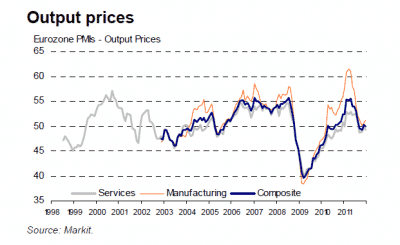
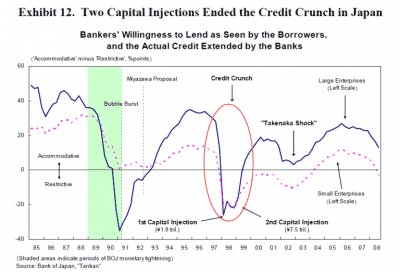
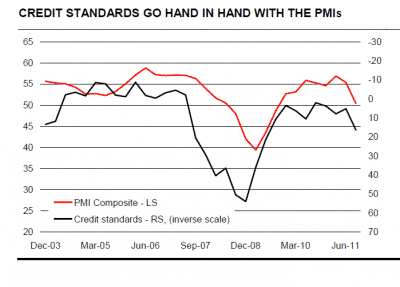
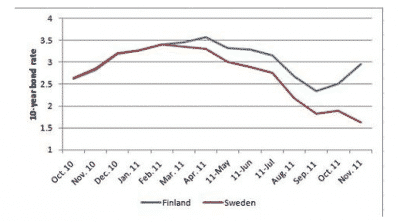
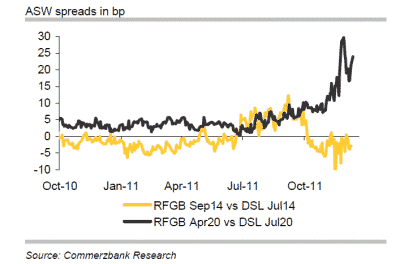
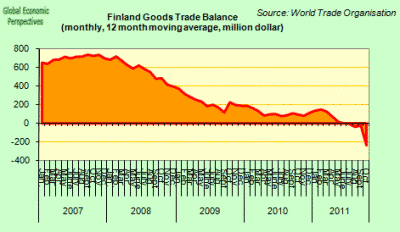
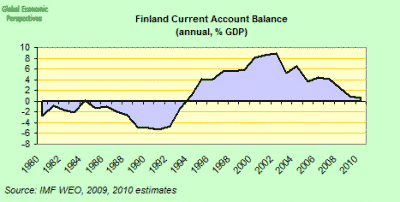
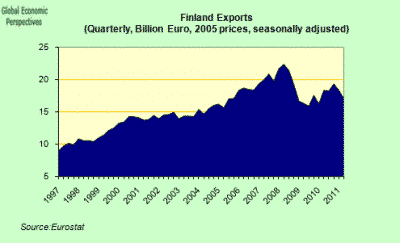
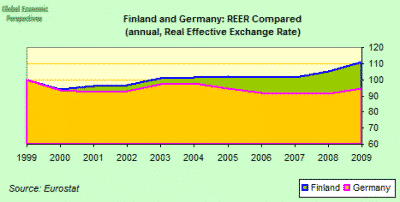
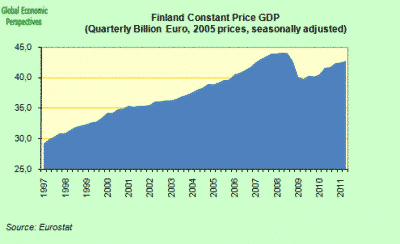
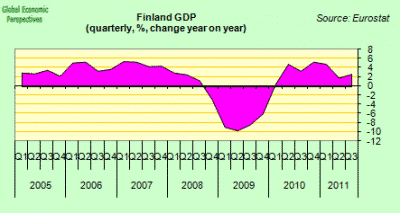
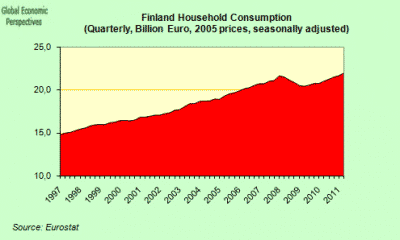
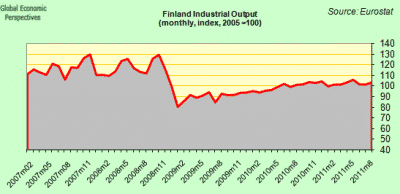
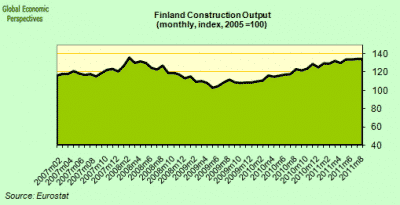
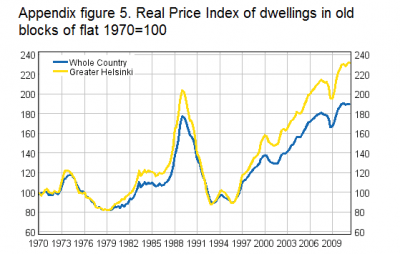
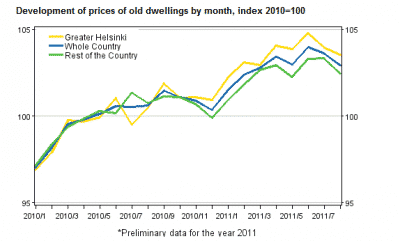
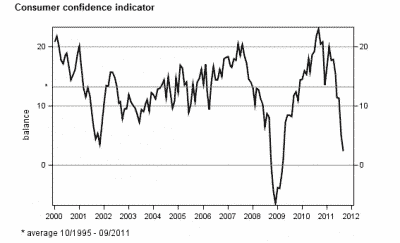
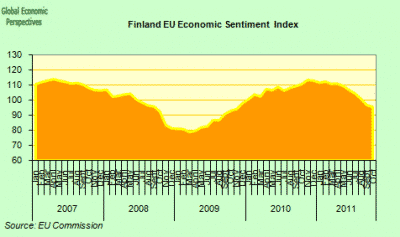
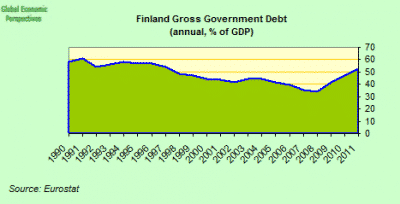
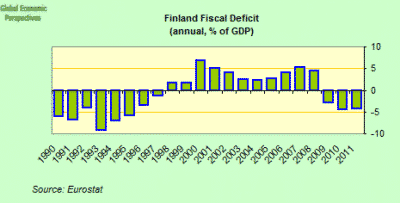
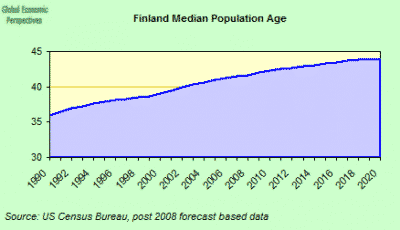
“And the comparison between the way industrial output failed to recover,
while construction output really took off is another warning signal.”
Renewed construction is a sign of health, not one of alarm. The reason Finland avoided a housing bust is that there’s a major housing shortage in Finland’s cities. The shortage was exacerbated in 2009 by the financial crisis drying up credit for construction companies. If you were looking for a three-room apartment in the capital region (Helsinki, Espoo & Vantaa) in 2010 then for most of the year you could literally count the units on sale on the fingers of one hand. The best way to get prices down is to build more and that’s what’s
being done.